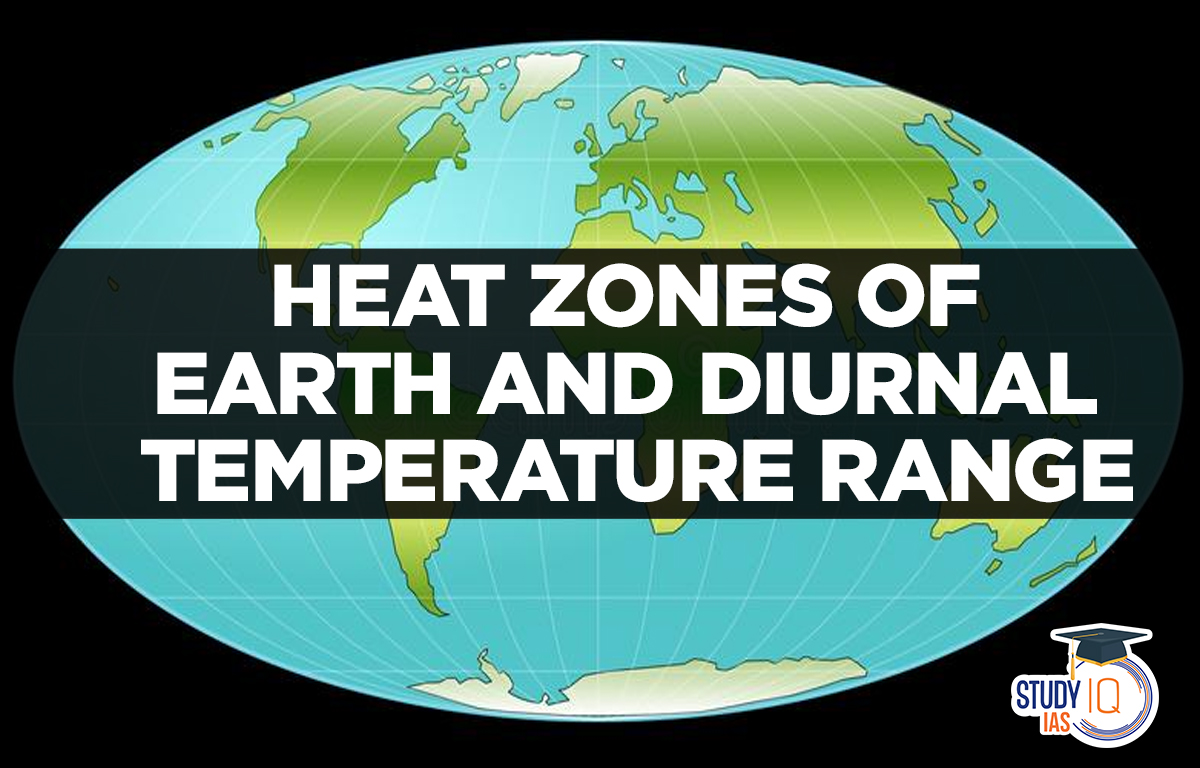Table of Contents
Heat Zones of Earth
Heat zones are the different regions of the earth where the sun’s rays fall differently, causing different climate patterns. There are three major Heat Zones on the Earth classified based on the amount of insolation received from the Sun. They are based on the distance they have from the equator. The three Heat Zones of Earth or temperature zones are:
- The Temperate Zone
- The Torrid Zone
- The Frigid Zone
Read More: Heat Waves
Temperate Zone
The Temperate Heat Zone is the most habitable zone of the Earth. There are two temperate zones in two respective hemispheres of the Earth. The North Temperate Zone lies between the Tropic of Cancer (23.5°N) and the Arctic Circle (66.5°N) in the Northern Hemispheres. The South Temperate Zone lies between the Tropic of Capricorn (23.5°S) and to Antarctic Circle (66.5°S) in the Southern Hemisphere.
The sun’s rays neither fall directly on this as that of the torrid zone nor are they slanting as that of the frigid or polar regions. The regions have tolerable temperatures. The major climate types found in these regions are- Western British Type climate, Siberian Type of Climate, China Type of Climate, Laurentian Type of Climate, and Mediterranean Type of Climate. etc.
The type of vegetation found in this region are- Deciduous Forests, Evergreen Coniferous Forests, Warm and Moist Forests, Mediterranean forests, and Shrubs.
Read More: Heat Transfer
Torrid Zone
The torrid or tropical zone is the hottest zone of the Earth. This region lies within the Tropic of Cancer (23.5°N) and Tropic of Capricorn (23.5°S). The Sun’s rays directly fall on this region at least once a year. This zone is characterized by the Hot Desert, Sudan Type of Climate, Monsoonal Type of Climate, and Hot and Wet Equatorial Type of Climate. The vegetation found in the torrid zone is Desert Vegetation, Equatorial Rain Forests, Monsoon Forests, and Savanna Grasslands
Read More: Structure of the Atmosphere
Frigid Zone
The Frigid zone or the Polar zones are the coldest zones of the Earth. This zone lies to the north of the Arctic Circle (66.5°N) and to the south of the Antarctic Circle (66.5°S). The zone remains permanently frozen. No sunlight is there for most of the months of the year in this zone. Arctic or Polar Type of Climate is found in this zone with Tundra Vegetation. Mostly mosses and lichens are found in this zone.
Heat Zones of Earth Diagram
Below is the illustration of the Frigid Zone, the Temperate Zone and the Torrid Zone:

Heat Zones of Earth Diurnal Temperature Range
The diurnal range of Temperature is the variation between the high and low temperatures on the same day. Changes in the diurnal temperature range are responsible for cloud cover, urban heat, land use change, aerosols, water vapour, and greenhouse gases.
The diurnal range of temperature also expands as the distance from the sea grows. The diurnal range of temperature rises in dry tropical climates and on high mountain plateaus when solar radiation is at its highest.
Diurnal Temperature Range Details
The temperature of a place varies within a day and differs in different seasons. The range of temperature is the difference between the maximum and minimum temperatures. When discussing temperature ranges, two terms are used.
Diurnal Range of Temperature
The normal daily pattern of temperature change illustrates energy changes on a small time scale. On a clear day with little cloud, air temperatures usually fall just before sunrise because the ground has been emitting long-wave radiation all night, gradually cooling and cooling the air above by conduction. The temperature of the ground begins to rise as the sun rises. Midday saw the highest level of Insolation. However, the air temperature frequently reaches its peak around 2:00 PM. After sunset, the air remains relatively warm because it is still heated by long-wave radiation from the ground, but this gradually fades. Desert areas have the greatest diurnal temperature variations, while low-lying, humid areas have the least.
Annual Average Temperature Range
It is the monthly range of temperature or the difference between the average temperature of the hottest month and the average temperature of the coldest month of the year. The yearly range of low latitudes is smaller than that of high latitudes. It is higher over the continents and lower over the oceans and coastal regions in the same latitudes. The highest annual range of temperature is more than 60° C over the northeastern part of the Eurasian continent. This is due to continentality. The 3°C temperature range with the narrowest range is found between 20° S and 15° N.
Read More: Isotherms
Heat Zones of Earth UPSC
The lowest and highest numbers in the data collection are used to calculate the temperature range throughout the day. The set’s highest number is deducted from its lowest one. The outcome value is the range of the collection of temperature values.
The average monthly lowest temperature is subtracted from the annual average monthly maximum temperature to determine the annual range of temperature. This article will discuss an important topic diurnal temperature range and heat zones of the earth in the context of the UPSC IAS Exam.


 Role of Teachers in Educations, Student ...
Role of Teachers in Educations, Student ...
 India's achievements after 75 years of I...
India's achievements after 75 years of I...
 Bal Gangadhar Tilak Biography, Achieveme...
Bal Gangadhar Tilak Biography, Achieveme...

























